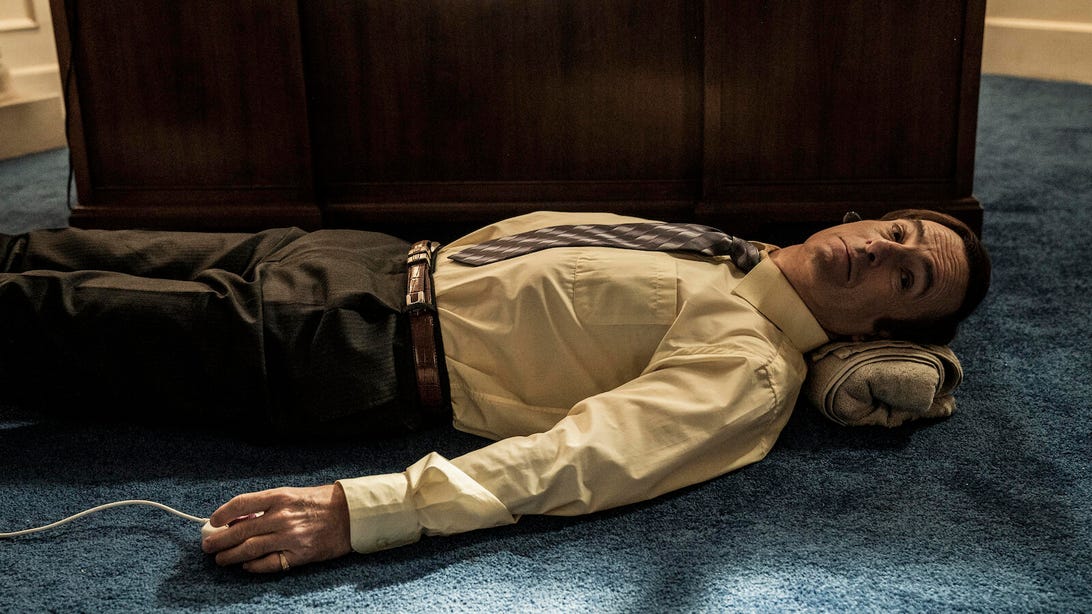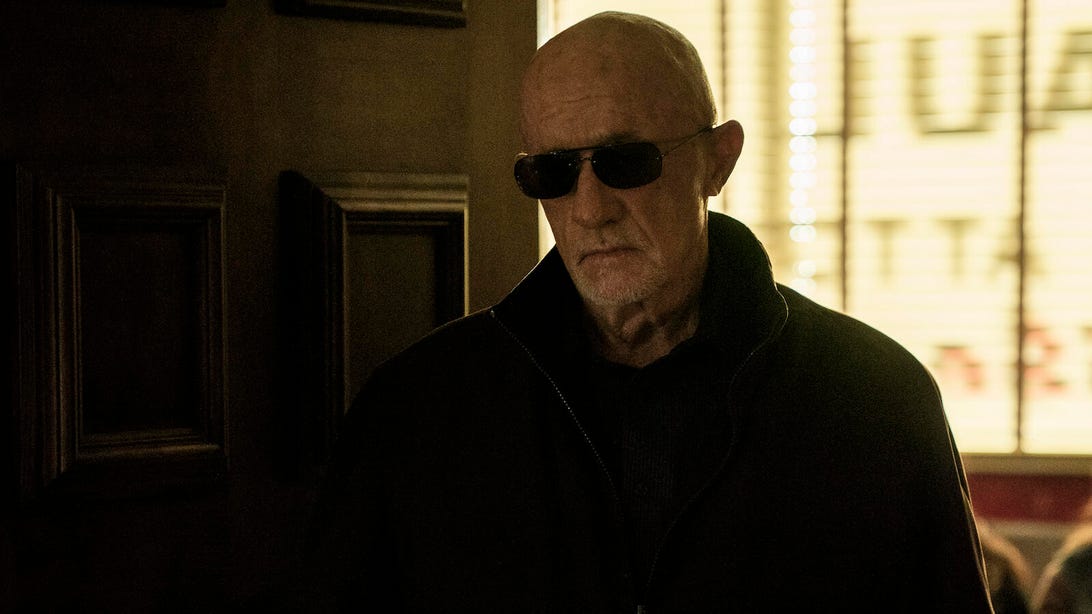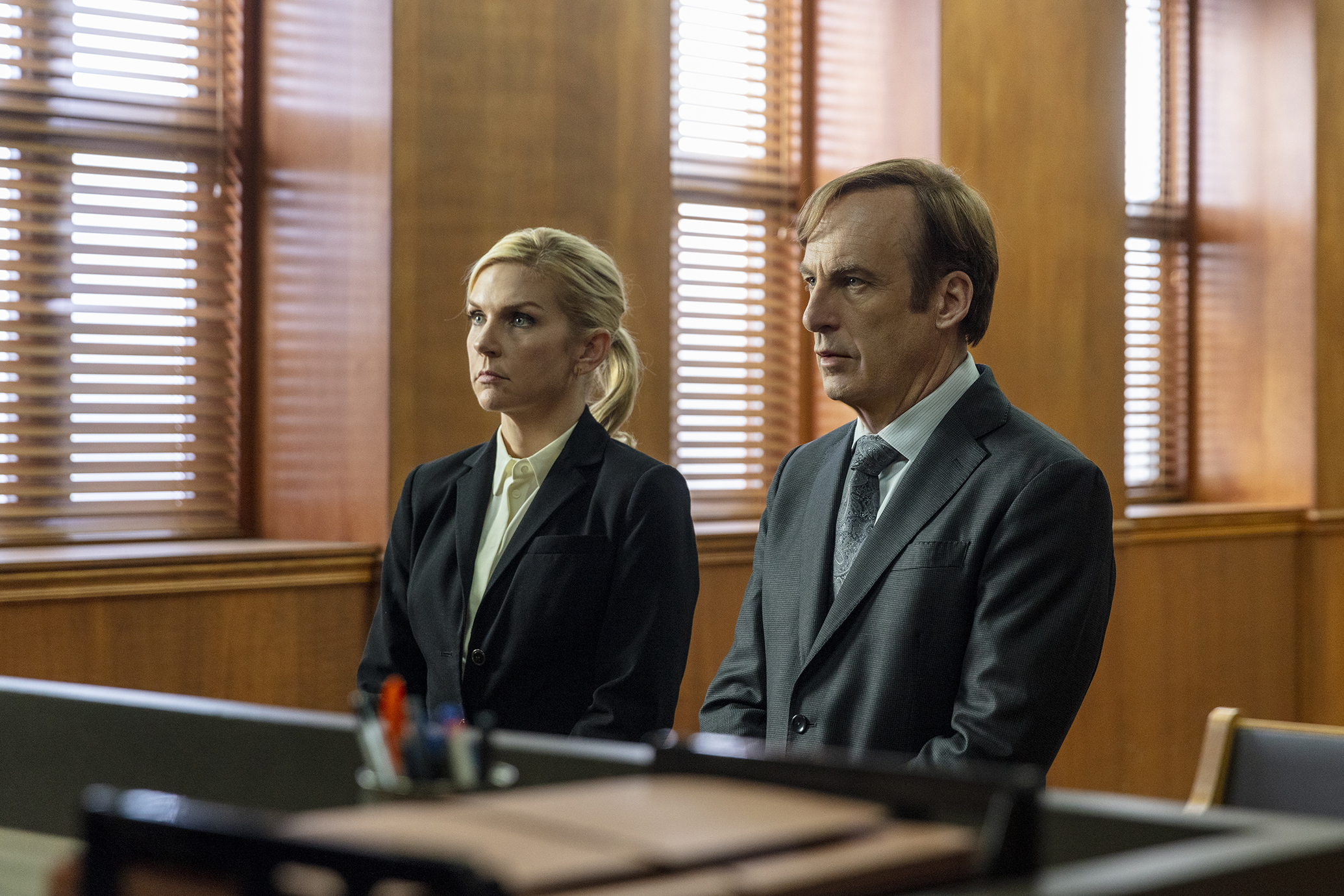Join or Sign In
Sign in to customize your TV listings
By joining TV Guide, you agree to our Terms of Use and acknowledge the data practices in our Privacy Policy.
Better Call Saul Writer-Director Thomas Schnauz on How Gene's 'Emotional Struggle' Influenced Those Breaking Bad Cameos
'He again needed that drug of Saul Goodman to numb that pain'

Bob Odenkirk, Better Call Saul
Greg Lewis/AMC/Sony Pictures Television[Warning: The following contains spoilers for Season 6, Episode 11 of Better Call Saul, "Breaking Bad." Read at your own risk!]
Before the final season of Better Call Saul even started airing, we knew exactly one thing for certain: Walter White (Bryan Cranston) and Jesse Pinkman (Aaron Paul) would appear. The only question that remained was when. In this week's episode, appropriately titled "Breaking Bad," we finally got our answer. (Although, if you were online at all over the weekend, you might have already seen the news that Vince Gilligan confirmed their cameos would air this week.)
But, of course, this is Better Call Saul, not Breaking Bad, and here, Walt and Jesse are footnotes in Saul Goodman's (Bob Odenkirk) story. It's a thoughtfully constructed episode, written and directed by Thomas Schnauz, that smartly shifts the perspective of the memorable Breaking Bad hour that originally introduced us to Saul, Season 2's "Better Call Saul." We watch that infamous desert scene through Saul's eyes, as he's kidnapped, tied up, and forced to kneel in the dirt. In this context, knowing everything we know about what he's recently been through, his pleas ("Anywhere but the desert!") and panicked deflections ("It wasn't me! It was Ignacio!") take on devastating new resonance, a far cry from his origin as Breaking Bad's comic relief.
That's not the only clever element at work in this episode, as the story splits between Breaking Bad-era Saul and the future that awaits him, where Gene Takovic continues his downward spiral. Gene calls Francesca (Tina Parker) on the date he promised he would call her right before he went into hiding (which fans saw in Season 4). We find out that after he vanished, Francesca got a call from Kim (Rhea Seehorn), asking if Jimmy is alive. After a second call that Schnauz keeps vague — but perhaps, the episode suggests, he's speaking to Kim, who we learn has been living in Florida — leaves Gene furiously slamming down the payphone and kicking a hole in the booth's glass, something breaks within him. In complete disregard of the fact that he's supposed to be in hiding, he ropes Jeff (Pat Healy) and Buddy (Max Bickelhaup) in for another, much more sinister scheme that involves drugging unsuspecting men in bars and stealing their identities.
The episode ends with Gene doggedly choosing to go through with the plan to steal the identity of a man with cancer (Kevin Sussman), which is all tied together by a mirroring cut to the Breaking Bad moment in which Saul officially took on Walter as a client. "A guy with cancer can't be an a--hole? Believe me, I speak from experience," Gene tells Buddy, who pushes back against the idea of scamming a sick person. Here, Gene indulges in his most Saul-like instincts until he transcends them entirely, morphing into the darker fourth iteration of himself Odenkirk has previously hinted at.
With only two episodes left before the series signs off for good, TV Guide caught up with Schnauz to unpack the making of the episode, bringing Walt and Jesse into the Saul universe, and the "new creature" Gene-Saul-Jimmy has become.

Bob Odenkirk, Better Call Saul
Greg Lewis/AMC/Sony Pictures TelevisionI am a Kim Wexler fan first and foremost, so I need to ask you: Is that Kim who Gene is talking to on the phone?
Thomas Schnauz: We don't know in this episode. We will know in a future episode what exactly he heard and was told on the phone call. And like you, I am a Kim Wexler fan, and Rhea Seehorn delighted in giving me crap that I didn't use her in the episode. She kept asking me, "Why do you hate me?" Unfortunately, at this part of the story, we wanted to keep the mystery of what happened to Kim Wexler going.
Beyond retaining an air of mystery, what was the thought behind creating that separation by shooting the phone call across the street, with only some muffled sound?
Schnauz: We had just gone through a very long phone call with Francesca, and so when we were breaking the episode, we were like, do we do another phone call? Or, boy, it'd be interesting to not know what happened on that phone call and reveal it later. It just felt like another phone call was gonna be just a very long scene, so it felt better to get right to the emotion of what happened during that phone call and how that emotion spiraled him into what happens in the rest of the episode. Something on that phone call caused him pain — he again needed that drug of Saul Goodman to numb that pain.
When I spoke to Bob last week, he talked about Gene not being able to keep a handle on the Saul side of him. In this episode, it was interesting watching Gene descend back into the Saul persona at the same time as these Breaking Bad flashbacks were happening. Then, at the end, Saul goes to visit Walt at the high school at the same moment Gene is breaking into the house of the guy who has cancer. I'm curious about what went into creating those parallels.
Schnauz: When we were talking about, all of us as fans of the previous show, wanting to see [Walter and Jesse], and why bring them back now? They had to have a reason. I think [it came down to] highlighting the emotions that were going on then and now, as far as Saul needing to up his game and go even further and get something that's his own, which he thinks is Walter White. He's gonna go in and help this guy become this mound of clay. He's gonna mold it and shape it so that [Walter] can be a successful drug kingpin.
Now, he's a whole other creature entirely. He's not quite Saul, he's not Jimmy. He's the guy who's drugging people and stealing their money. But he thinks it's what he needs to do. It's the tools that he has. He has Jeff and Buddy, what can he do with them? Well, this is the best he can do. He doesn't have a Kim Wexler. He doesn't have a Marco. This is the scam he can get away with. And again, he's got all this pain. Instead of dealing with it the way that Patrick Fabian's character, Howard Hamlin, did when he thought the death of Chuck was his fault, he went to therapy, he did all this work that helped him through it. All the stuff that Jimmy should be doing, he never did. So he's got all this emotional stuff that he keeps pushing down and pushing down and pushing down, and the more he pushes it down, the more it wants to rise up like a volcano, and he needs to do even worse stuff. You know, it's like, oh, there's a guy with cancer? Oh boy, maybe I'll let this one go. You know what, nope, here's the pain coming up, we're gonna take him down too.
It's also interesting that he chooses to go by Viktor when he's doing this scam. That identity is very deeply tied into his relationship with Kim. Clearly, he's thinking about her.
Schnauz: Yeah, it's a real stew up there. It's a real mix of Jimmy, and Viktor and Giselle, and Saul Goodman. He's doing whatever he can to cover up the hurt.
I love the way the scam comes together, and all the details: that great Monkees cover, Gene sleeping with strippers but seeming very detached from it. How does mapping out a sequence like this work? I'm sure when you were writing the episode, you were envisioning how certain shots would look, but did anything change while you were actually shooting?
Schnauz: I storyboard everything that I do, and I was doing a lot of pictures, and I wrote a lot of different visuals and shots. I had some ideas how some transitions would happen, but not everything. Nothing really changed in the shooting of it, everything was scripted. It got smaller, because we couldn't do everything, but we did shoot more than what was used in the final montage, just to match the length of the song. That's the original Mike Nesmith demo of that song.
I was wondering what it was.
Schnauz: Yeah, it's from the 1960s. He recorded it, and it eventually became the Monkees song that was much more psychedelic, the version that was on the record. But I'm a huge Monkees fan, I saw Mike Nesmith in concert do that song on an acoustic guitar and it always stuck with me. And I told our music supervisor, Thomas Golubić, you know, it's on YouTube, him on stage, can we get it? But he found the original demo. It was on a Monkees compilation. And I was like, "Great, I want to use this." My first directing for the universe was Breaking Bad [Season 5, Episode 7], and I used a Monkees song, "Goin' Down," and now this is my last directing for the universe and I get to use another Monkees song.
Those lyrics are so fitting for what's going on.
Schnauz: It had a different meaning when [Nesmith] wrote about it, it's about the band's connection with the audience. But that line, "It cannot be a part of me, for now it's a part of you," is just so… it fits so well with Jimmy-Gene-Saul trying to put who he is — you know, "I'm not that person anymore. It's part of this person." It just feels like it works so well with the emotion that he's going through.

Jonathan Banks, Better Call Saul
Greg Lewis/AMC/Sony Pictures TelevisionTo shift gears a bit, we obviously have to talk about Walt and Jesse.
Schnauz: Who?
Heard of them? You alluded to this earlier, but was it always the plan to eventually bring them back? Why did this feel like the right moment?
Schnauz: It was always a thought. We went back and forth, we didn't know, could we get these actors together, because they're doing their separate things? And I think we tried to make ourselves feel better by saying, "Well, they were in El Camino together. That exists, so if we never get to them, then it's OK." But as we got into the final season, we were talking about, "Boy, it'd be really great to see them again, but why do we want to see them?" It felt like showing Gene's emotional struggle, what he was going through and why he's going after Jeff and Buddy to do these scams, matched very well with Saul Goodman and why he went after Walter White to do the things that they did together, just to cover up the pain that he was feeling from losing Kim Wexler.
Can you talk about recreating Saul's Breaking Bad introduction?
Schnauz: There's a little snippet of audio that is actually from the original, the transition from once we go outside the RV, the door closes on us, and before he gets kneeled down, you hear a little snippet of the original audio from Breaking Bad that we took, just to match it. Yeah, we just wanted to show it more from Saul's point of view, the fear he went through, and hopefully remind him and everybody else watching of the pain he went through when Lalo gagged him in front of Howard's corpse, which is why he has this horrible flashback. "Oh my god, is this Lalo back from the dead again, is he sending his people after me, what's going on? It wasn't me!" So that line he's saying as he gets gagged in Gordon [Smith] and Vince's episode is what pops up again, in this recreation of the Breaking Bad scene from episode 208.
Breaking Bad was shot on film, and Better Call Saul has always been shot on digital. I'm curious how, if at all, that affected the styling of the Breaking Bad-era scenes.
Schnauz: Definitely. Marshall Adams, our great DP, has his own visual style, but when we did this section, he looked at [Breaking Bad cinematographer] Michael Slovis' great work and tried to model the colors and the lighting after that, so it seemed that he probably normally wouldn't have shot this particular way. He lit it in a certain way so that it would blend in more with the Breaking Bad era stuff. We did not shoot on film, but I think we put a little grain filter on it, so it has a little more of a film look. Everything we did, we went from our dollies and tripods to almost all handheld in the scene to match the Breaking Bad look.
Peter Gould has spoken about how the final episodes morph into a nebulous third thing that goes beyond both Breaking Bad and Better Call Saul. Is this episode signifying the beginning of that?
Schnauz: Oh, definitely. Very early on in Season 1, when we talked about, "What is this show gonna be?" There was this phrase of "dancing through the raindrops," which was a mix of the current Jimmy McGill world with the future of Saul Goodman's world. Were we going to bounce back and forth more than we have? I was always pushing for, "Let's dance through the raindrops more. Let's see more of the future." We didn't really get into it until Season 4 [Episode 5] when we did that Saul Goodman teaser, which I think they did shoot on film. We didn't do it this time, we really talked about it a lot, but in the end it didn't make financial sense or even artistic sense, because of how good we could match the digital to look like the film look, so we ended up shooting digitally. Anyway, yeah, this is us really dancing through the raindrops and bringing all the different stories together.
Better Call Saul airs Mondays at 9/8c on AMC.

